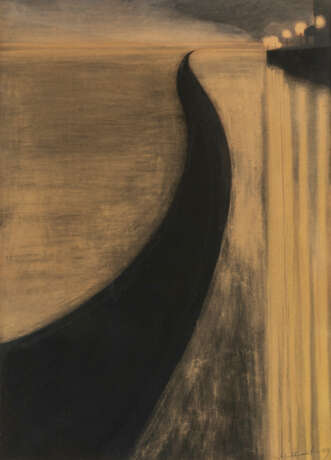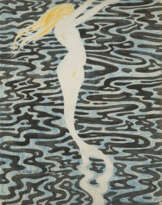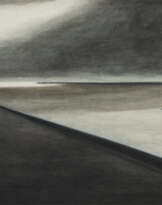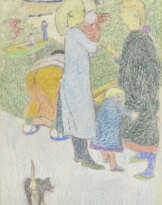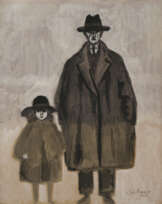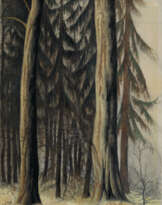ID 929387
Los 22 | Léon Spilliaert (1881-1946)
Schätzwert
€ 300 000 – 500 000
Digue et lumières d'Ostende
signé et daté 'L Spilliaert 09' (en bas à droite)
encre de Chine, lavis d'encre de Chine et crayon de couleurs sur papier
70.8 x 49.8 cm.
Exécuté en 1909
signed and dated 'L Spilliaert 09' (lower right)
brush and India ink, wash and India ink and coloured crayon on paper
27 7/8 x 19 5/8 in.
Executed in 1909
Provenance
Collection particulière, Belgique (acquis auprès de l'artiste vers les années 1920).
Puis par descendance au propriétaire actuel.
Literature
A. Adriaens-Pannier, 'Léon Spilliaert', in Galerie Patrick Derom, 6 Symbolist works, Bruxelles et New York, 2005, p. 55, ill. 3 (illustré en couleurs).
A. Adriaens-Pannier, Léon Spilliaert, Le regard de l'âme, Gand, 2006, p. 118, no. 156 (illustré en couleurs).
A. Adriaens-Pannier, Léon Spilliaert, From the Depths of the Soul, Bruxelles, 2019, p. 118 (illustré en couleurs).
Exhibited
Anvers, Galerie Guillaume Campo, Spilliaert, octobre-novembre 1965, no. 32.
Winnipeg, The Winnipeg Art Gallery, Léon Spilliaert, avril-juin 1985, no. 24.
Ostende, Venetiaanse Gaanderijen, Brise d'Ostende, Oostende in het œuvre van Léon Spilliaert, juin-septembre 2006 (hors catalogue).
Post lot text
Par une maîtrise étonnante du médium employé de l’encre de Chine et des crayons de couleurs dont Spilliaert explore toutes leurs subtilités, Digue et lumières d'Ostende nous plonge dans le monde mystérieux et poétique de Spilliaert, avec ce tracé sinueux noir qui nous entraîne vers l’horizon de cette vue légendaire de la digue d’Ostende. Cette œuvre est restée dans la même famille depuis son acquisition auprès de l’artiste il y a environ cent ans par les grands-parents du propriétaire actuel, qui faisaient partie du cercle artistique belge, étant notamment proches de Léon Spilliaert, mais aussi de de l’artiste James Ensor (1860-1949).
L’intérêt du jeune Léon Spilliaert (1881-1946) pour la littérature universelle est légendaire, il s’absorbe dans les écrits de Frédéric Nietzsche, d’Edgar Allan Poe, de Maurice Maeterlinck, des classiques Ovide et Virgile et s’intéresse plus tard aux mystiques Thérèse d’Avila et Ruysbroeck l’Admirable. Tout au long de sa vie ses créations reflèteront un esprit de réflexion et de méditation spirituelle. Un bref passage à l’Académie de Bruges renforce sa conviction de ne pas laisser envahir son art par une éducation académique traditionnelle. Brièvement au service de l’éditeur bruxellois Edmond Deman, Spilliaert est introduit en 1904 par Emile Verhaeren dans le milieu artistique parisien.
Se détournant rapidement d’une imagerie teintée d’accents symboliques littéraires, il est avant tout inspiré par la présence constante de la mer se déployant sur les plages de la ville d’Ostende où il vit et travaille. Il se livre inlassablement sur le papier à des expériences privilégiant l’emploi de l’encre de Chine, l’aquarelle et les crayons de couleurs, créant des compositions uniques fascinantes par leur acuité et le mystère de leurs images. Dans une série d’autoportraits saisissants de vérité, il traduit en 1907-1908, l’angoisse de la recherche vers le plus profond de son être. Marcheur solitaire et nocturne, il évoque la solitude de l’être humain confronté à l’immensité de la nature. La digue et ses perspectives sont en 1908-1909, ses motifs de prédilection, elles se transforment dans des zones géométriques floues où la ligne prédomine à la frontière de l’abstraction. L’architecture se confond aux éléments naturels, la structure de la composition en diagonales vertigineuses procure une sensation d’infini, exprimant conjointement inquiétude et recherche de liberté. La monumentalité de la masse architecturale s’oppose aux cieux bas et tourmentés transpercés par une éclaircie menaçante et ancrés par un rai de lumière qui relie symboliquement terre et ciel.
Digue et lumières d'Ostende sous cette lumière nocturne souligne la fonction de la transfiguration du réel et la dématérialisation de la réalité. Bien en avance en son temps, certaines des trouvailles formelles de Spilliaert seront portées par d’autres à leur aboutissement, souvent dans un contexte théorique. Aucune de ses œuvres n’indique cependant, dans son élaboration structurelle, l’application systématique d’un modèle prédéterminé. Simplifier et synthétiser, telle est la base de son langage. Son œil de visionnaire impénitent variera tout au long de sa carrière et le conduira infailliblement vers l’essentiel de ses expressions transparentes de vérité et d’originalité, ce qui fait de lui l’exemple par excellence de l’artiste régi principalement par l’agent de l’esprit intemporel.
Anne Adriaens-Pannier
Mastering in the most astonishing way the medium used of India ink and colored crayons, of which Spilliaert explores all their subtleties, Digue et lumières d'Ostende plunges the beholder in Spilliaert’s mysterious and poetic realm, as we are led to follow that winding black route to reach the horizon line of the legendary view of Ostende’s dam. The present drawing has remained in the same family hands since it was acquired directly from the artist around a hundred years ago by the current owner’s grand-parents, who mingled with the Belgian artistic circle, being close friends of Léon Spilliaert but also of the artist James Ensor (1860-1949).
The passion the young Léon Spilliaert (1881-1946) harbored for world literature is legendary. He immersed himself in the writings of Frédéric Nietzsche, Edgar Allan Poe and Maurice Maeterlinck; the classics by Ovid and Virgil; and, later, the mystic works of Teresa of Ávila and John van Ruysbroeck. Throughout his life, his art would suggest a spirit of reflection and spiritual meditation. A brief stint at the Academy of Fine Arts in Bruges cemented his belief that he should not let his art be influenced by a traditional artistic education. Spilliaert worked for a short time for the Brussels publisher Edmond Deman, then in 1904 Emile Verhaeren introduced him into Parisian art circles.
Turning quickly to images tinged with symbolic literary accents, he was inspired first and foremost by the constant presence of the sea unfurling on the beaches of Ostend, the city where he lived and worked. He experimented tirelessly on paper, with India ink, watercolor and colored crayons, creating unique compositions that are fascinating for their sharpness and the mysteriousness of their imagery. In a series of strikingly truthful self-portraits in 1907-1908, he conveyed the anguish of delving into the depths of his being. Known for his solitary, nocturnal walks, he references the solitude of humankind before the immensity of nature. The dam and its many angles were his preferred subjects in 1908-1909. He transforms them into blurred geometric forms where lines dominate at the edge of abstraction. As the architecture melts into natural features, the structure of the composition slanting at vertiginous angles creates a sense of the infinite, expressing both trepidation and a quest for freedom. The monumentality of the architectural mass contrasts with the low, tormented sky pierced by a menacing break in the clouds and grounded by a ray of light symbolically linking earth and the heavens.
Digue et lumières d'Ostende in this nocturnal light, emphasizes the function of the transfiguration of the real and the dematerialization of reality. Spilliaert was well ahead of his time. Some of his formal discoveries would be taken up and fully realized by others, often in a theoretical context. None of his works, however, suggests the systematic application of a predetermined model in their structural development. Simplify and synthesize: these were his guiding principles. His unrepentant visionary eye would morph throughout his career and lead him unerringly to the essence of his transparent expressions of truth and originality, making him the epitome of an artist ruled primarily by the agent of a timeless spirit.
Anne Adriaens-Pannier
| Künstler: | Léon Spilliaert (1881 - 1946) |
|---|---|
| Material: | Acrylglas, Kunststoff |
| Herkunftsort: | Belgien, Westeuropa, Europa |
| Künstler: | Léon Spilliaert (1881 - 1946) |
|---|---|
| Material: | Acrylglas, Kunststoff |
| Herkunftsort: | Belgien, Westeuropa, Europa |
| Adresse der Versteigerung |
CHRISTIE'S 9 Avenue Matignon 75008 Paris Frankreich | ||||||||||||||
|---|---|---|---|---|---|---|---|---|---|---|---|---|---|---|---|
| Vorschau |
| ||||||||||||||
| Telefon | +33 (0)1 40 76 85 85 | ||||||||||||||
| Fax | +33 (0)1 40 76 85 86 | ||||||||||||||
| Nutzungsbedingungen | Nutzungsbedingungen | ||||||||||||||
| Versand |
Postdienst Kurierdienst Selbstabholung | ||||||||||||||
| Zahlungsarten |
Banküberweisung | ||||||||||||||
| Geschäftszeiten | Geschäftszeiten
|
